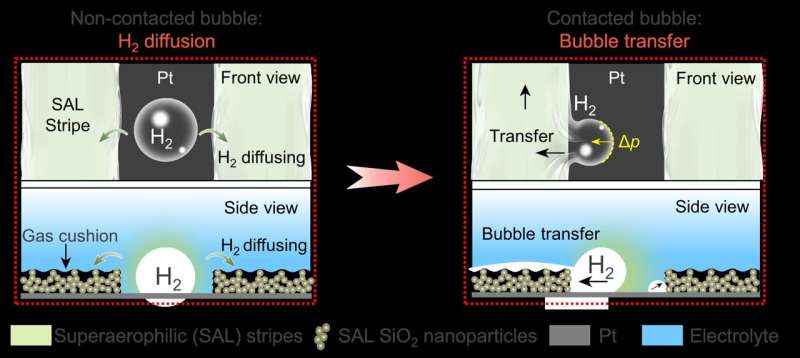This article has been reviewed according to Science X's editorial process and policies. Editors have highlighted the following attributes while ensuring the content's credibility:
fact-checked
peer-reviewed publication
trusted source
proofread
Better hydrogen transfer brings better hydrogen evolution reaction performance

The electrocatalytic hydrogen evolution reaction (HER) is one of the most efficient methods for producing green hydrogen. However, the inefficient mass transfer of hydrogen has greatly impeded HER efficiency.
The mass transfer of hydrogen has two main types: gaseous bubble transfer and dissolved hydrogen diffusion. Inefficient bubble transfer will cause bubble adhesion and dispersion problems, while inefficient hydrogen diffusion will cause oversaturated dissolved hydrogen and result in high concentration overpotential.
In a new study, a joint research team led by Prof. Yu Cunming from Beihang University and Prof. Jiang Lei from the Technical Institute of Physics and Chemistry of the Chinese Academy of Sciences (CAS) has reported a superaerophilic/superaerophobic cooperative electrode that can promote bubble removal and dissolved hydrogen diffusion to achieve efficient HER.
Results were published in Science Advances on Jan. 18.
In this study, the researchers introduced superaerophilic stripes on a Pt electrode; these stripes are covered with gas cushions and act as gas channels to transport hydrogen out.
For non-contacted bubbles, the diffusion distance of dissolved hydrogen is greatly decreased due to the existence of gas cushions on the superaerophilic stripes, thus accelerating dissolved hydrogen diffusion. For contacted bubbles, the bubbles can be quickly transferred by asymmetric Laplace pressure between the exposed Pt surface and the superaerophilic stripes.
Prof. Yu said that HER is like a production line, with hydrogen ions as the raw material, the catalyst as the production machinery and hydrogen as the product. However, if the catalyst is excellent but the hydrogen product cannot be removed from the surface of a catalyst in a timely way, the production line will be blocked.
"Here, we designed a transport line, superaerophilic stripes, specialized for hydrogen delivery, which greatly avoids blocking the production line and improves efficiency," said Prof. Yu.
Based on more efficient hydrogen transfer, including through gaseous bubbles and dissolved hydrogen, the superaerophilic/superaerophobic cooperative Pt electrode can achieve much better HER. Its overpotential at -10 mA cm-2 is -19 mV, compared with -61 mV on a traditional flat Pt electrode.
Prof. Yu also noted that the superaerophilic/superaerophobic cooperative strategy can be applied not only to HER but also to other gas evolution reactions.
More information: Chunhui Zhang et al, Superaerophilic/superaerophobic cooperative electrode for efficient hydrogen evolution reaction via enhanced mass transfer, Science Advances (2023). DOI: 10.1126/sciadv.add6978. www.science.org/doi/10.1126/sciadv.add6978
Journal information: Science Advances
Provided by Chinese Academy of Sciences


















